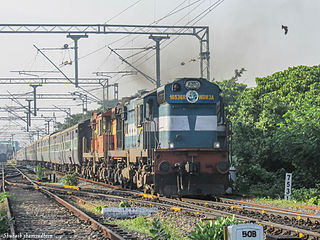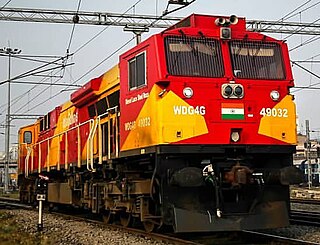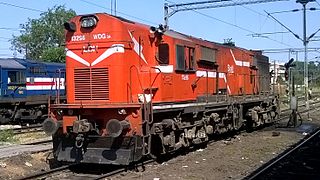
The American Locomotive Company was an American manufacturer that operated from 1901 to 1969, initially specializing in the production of locomotives but later diversifying and fabricating at various times diesel generators, automobiles, steel, tanks, munitions, oil-production equipment, as well as heat exchangers for nuclear power plants.
The Indian locomotive class WDM-2 is a class of diesel-electric locomotive that was developed in 1962 by American Locomotive Company (ALCO) for Indian Railways. The model name stands for broad gauge (W), Diesel (D), Mixed traffic (M) engine, 2nd generation (2). They entered service in 1962. A total of more than 2,700 WDM-2 was built at ALCO and Banaras Locomotive Works, Varanasi between 1962 and 1998, which made them the most numerous class of mainline diesel locomotive until its successor the WDM-3A.

The Indian locomotive class WDG-4 is a type of six-axle (Co-Co) freight-hauling diesel-electric locomotive with AC electric transmission designed by General Motors Electro-Motive Diesel in 1997–1998 for Indian Railways, where they are classed as WDG-4. Derived from the EMD SD70MAC, it is powered by a 4,000 hp (3,000 kW) 16-cylinder EMD 710G3B prime mover. Thirteen were built by EMD as order #958647, and a further eight were exported in kit form and assembled in India. The class entered service in 1999. This locomotive is also famous for, and can be identified by the distinct and unique Jet Plane-like sounding capability of its EMD 710 prime mover.

The Indian locomotive class WDP-4 is a passenger-hauling diesel-electric locomotive with AC electric transmission designed by General Motors Electro-Motive Division and built by both GM-EMD and under license by Banaras Locomotive Works (BLW) of Varanasi, India for Indian Railways as the classes WDP4, WDP4B and WDP4D. The GT46PAC is a passenger version of the previous Indian Railways EMD GT46MAC freight locomotive. The locomotive has a 16-cylinder 710G3B diesel engine and is one of the fastest diesel-electric locomotives in service in Indian Railways.
The ALCO DL560C is a series of diesel-electric locomotive with AC electric transmission designed by the American Locomotive Company and produced under license by Banaras Locomotive Works (BLW) Varanasi, India for Indian Railways as their classes WDM-2, WDM-3A/2C, WDM-3D and WDG-3A for operation in India. The locomotive is fitted with a 16-cylinder ALCO 251 B,C diesel engine. In the early 1960s Indian Railways needed a reliable diesel workhorse to gradually replace its steam locomotive fleet. Equal numbers of ALCO's DL560C and EMD's G16 were chosen for trials. More locomotives of each of these were purchased for more trials. Indian Railways was keen on producing these locomotives in the country rather than depending on imports. EMD did not agree for a Transfer-of-Technology, while ALCO did. Thus ALCO DL560C was chosen for the job due to its easy maintenance, reliability and simple operation. And from then on vast numbers of this loco in different configurations have been produced and remain the main diesel traction power of Indian Railways.

The Indian locomotive class WDM-4 is a class of diesel-electric locomotive that was developed in 1962 by Electro-Motive Diesel for Indian Railways. The model name stands for broad gauge (W), Diesel (D), Mixed traffic (M) engine, 4th generation (4). They entered service in 1962. A total of 72 WDM-4 locomotives were built between 1961 and 1962.

The Varanasi–Ayodhya–Lucknow line is a railway line connecting Varanasi and Lucknow, both in the Indian state of Uttar Pradesh. The main line was subsequently extended to Bareilly, Moradabad and Saharanpur and the entire line was thought of as the "main line" of Oudh and Rohilkhand Railway. An important branch line, the Prayagraj–Ayodhya line, which meets the main line almost at right angles, is included here. The main line is under the administrative jurisdiction of Northern Railway, a portion of the branch line is under the jurisdiction of North Central Railway.

The Varanasi–Raebareli–Lucknow line is a railway line connecting Varanasi and Lucknow, both in the Indian state of Uttar Pradesh. The line is under the administrative jurisdiction of Northern Railway.

The Indian locomotive class WDM-3A is a class of diesel–electric locomotive that was developed in 1993 by Banaras Locomotive Works (BLW), Varanasi for Indian Railways. The model name stands for broad gauge (W), Diesel (D), Mixed traffic (M) engine, with 3300 horsepower (3A). The WDM-3A is a later classification of earlier WDM-2C. They entered service in 1994. A total of 143+ were built at ALCO and Banaras Locomotive Works between 1994 and 2003 with rest of the 1246 units being rebuilt from WDM-2 which made them the most numerous class of mainline diesel locomotive until the WDG-4.

The Varanasi–Jaunpur City–Sultanpur–Lucknow line is a railway line connecting Varanasi and Lucknow, both in the Indian state of Uttar Pradesh. This line is under the administration of Northern Railway and Lucknow Charbagh Divisions.

The class YDM-4 is Indian Railways' workhorse diesel locomotive. The first units were imported fully built from the American Locomotive Company (Alco) in 1961. Since 1968, it has been manufactured in India by the Banaras Locomotive Works (BLW), Varanasi. The model name stands for metre gauge (Y), diesel (D), mixed traffic (M) engine. The YDM-4 has been the most successful diesel locomotive in the metre gauge operation of Indian Railways. The YDM-4A is a variant of the YDM-4 supplied by MLW. Originally equipped with vacuum brakes. Some were later equipped with dual brakes, particularly those working in the Northeast Frontier Railway were retrofitted with dual brake system by Lumding shed. The YDM-4 locos have a maximum speed of 100 km/h (62 mph), restricted to 85 km/h (53 mph).

Diesel Loco Shed, Gooty is an engine shed located in Gooty, Andhra Pradesh in India. It falls under the jurisdiction of Guntakal railway division of South Central Railway zone.

The Indian locomotive class WDG-4G is a class of dual-cabin freight-hauling diesel-electric locomotive used by the Indian Railways (IR). The locomotive is designed by GE Transportation and is based on its Evolution Series, which are used in North America. The class is meant for freight hauling and replaces the older American Locomotive Company (ALCO)-designed locomotives, which have been the mainstay diesels of Indian Railways since 1962. Equipped with a 12-cylinder fully turbocharged GEVO engine, it is claimed to be 50% more environmentally friendly than its predecessors and is the first in the country to be compliant with level one of the emission norms set by the International Union of Railways (UIC-1). The locomotive has two cabs for easy reversal, both of which are air conditioned.

The Indian locomotive class WDP-1 is a class of diesel-electric locomotive that was developed in 1995 by Banaras Locomotive Works (BLW) for Indian Railways. The model name stands for broad gauge (W), Diesel (D), Passenger traffic (P) engine, 1st generation (1). They entered service in 1995. A total of 69 WDP-1 units were built at Banaras Locomotive Works (BLW), Varanasi between 1995 and 1999.

The Indian locomotive class WDP-3A, colloquially nicknamed the Toaster, is a class of diesel-electric locomotive that was developed in 1998 by Banaras Locomotive Works, Varanasi for Indian Railways. The model name stands for broad gauge (W), Diesel (D), Passengers traffic (P) locomotive with 3100 horsepower (3A). The WDP-3A is a later classification of earlier WDP-2. They entered service in 1998. A total of 44 were built between 1998 and 2001.

The WDM-7 is a diesel-electric locomotive of Indian Railways. It has been manufactured by Banaras Locomotive Works (BLW), Varanasi. The model name stands for broad gauge (W), diesel (D), mixed traffic (M) engine. Today, these are found exclusively at Chennai Central and nearby area.

The Indian locomotive class WDG-3A is a class of diesel-electric locomotive that was developed in 1994 by Banaras Locomotive Works (BLW),Varanasi for Indian Railways. The model name stands for broad-gauge (W), Diesel (D), Goods traffic (G) engine, 3,100 hp (3A) locomotive. They entered service on 18 July 1995. A total of 1,164 WDG-3A units were built between 1994 and 2015 at BLW, Varanasi with a few units being produced by Diesel Loco Modernisation Works (DLMW) and Parel Workshop.

The Indian locomotive class WDS-6 is a diesel-electric locomotive used by the Indian Railways mainly for shunting and also for performing departmental duties. The model name stands for broad gauge (W), Diesel (D), Shunting (S) engine, 6th generation (6). As of April 2022, 375 units of this class are currently in use all over India.

Bangladesh Railway Class 6500 is a class of 1,676 mm gauge diesel-electric locomotives owned by Bangladesh Railway. There are 56 locomotives of this class, all manufactured by the Banaras Locomotive Works of India. All locomotives of this class are in service.
The WDM-2G is a class of diesel electric genset locomotive used in Indian Railways. It is one of the rarest locomotives in India with only two units being produced by Patiala Locomotive Works (PLW). The locomotives were produced with an intention of being fuel efficient and to be used for light to medium duties such as short passenger runs along with occasional shunting. They are one of the only two classes of locomotives in India to feature multiple prime movers, the other example being WDS-6G, which was designed solely for shunting. They have a rated power of 2,400 HP.
























